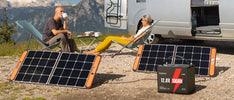
How to Hook Up Solar Panels to RV Batteries
, 4 min reading time


, 4 min reading time
Using solar power for RVs is a great way to provide energy independence to your already independent and self-sufficient lifestyle. You’ll save money on gas and electricity by producing your own. Plus, you’ll have the bonus of contributing to a cleaner energy source. Before you begin grabbing the first kit you see on the shelf, make sure you do your research and follow these steps.
Assessing your energy needs is important before you start purchasing the latest solar system. Doing so allows you to understand how much power your entire system needs to develop so you can comfortably use your system without losing power.
To calculate your energy consumption, you must first identify the appliances you use daily. This will include everything from your refrigerator to the chargers you use for your phone or laptop. Having an estimate is more important than getting the exact number as long as you have a list of appliances you have.
There are a few methods where you can find the wattage of the appliances you have.
Once you’ve found out how much energy you need to run your appliances, the next step is to figure out the requirements needed for your solar panels. Solar panels come in various sizes, styles, and energy specifications, so grabbing a random panel won’t offer the best results.
Determining your solar panel requirements is quite easy;, after determining your energy requirements, you can figure out exactly what you need out of your solar panels including:
After finding out what you need, the next step is to gather all the necessary components included in your solar system. These items include the following.

Once you have your components together, you need to ensure that your RV is solar-ready. This means getting all the necessary adapters and connectors together and making sure they can fit together and are long enough to reach one another. Usually, they’ll come with the components you already ordered, but you can purchase larger-size cables and connectors to ensure your components fit together.
When all is said and done, you can begin hooking up your solar panels with your RV. Although you can hire a professional to set it all up, it’s a fairly simple process that only requires a few steps.
When hooking up your solar panels to your RV batteries, be sure that your RV is not connected to any power system. Although it may be different, you are still working with electricity and all safety precautions should be taken.